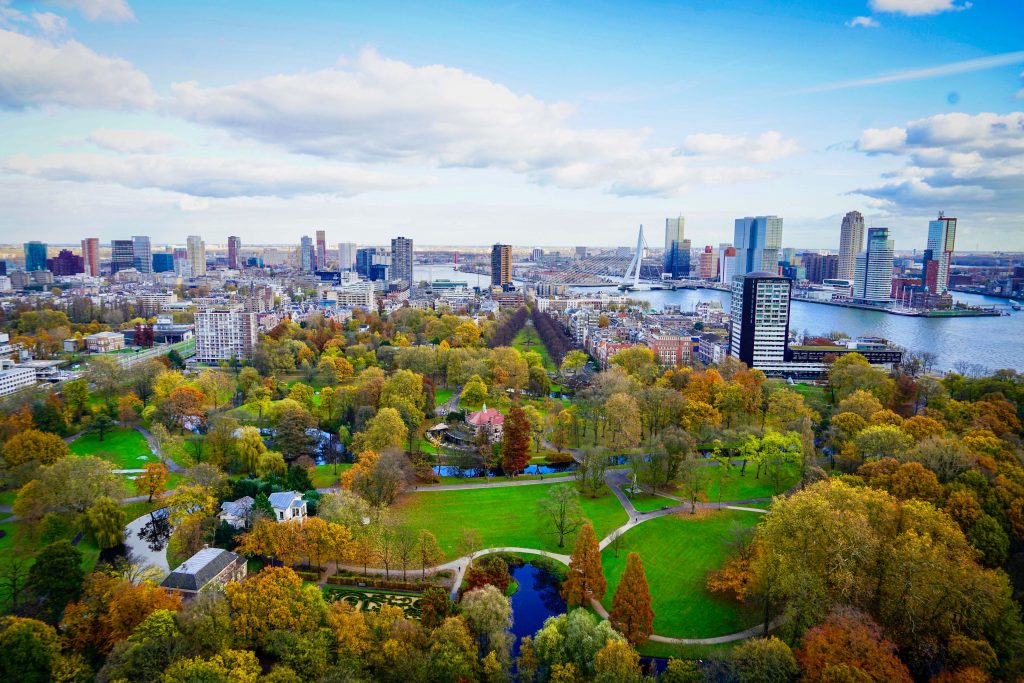Let’s be honest, greening your home is never cheap. It may pay off in the long run, but in the short run, gathering all necessary financial means may present many a challenge. There are ways past this, though, and it doesn’t all have to come out of your own pocket. The Programme Manager of the City of Rotterdam explains how.
We caught up with Johan Verlinde, Programme Manager of the City of Rotterdam’s Climate Adaptation Plan, called WeatherWise. He told us about the actors needed for obtaining financial support and the necessary parties to bring on board. Most importantly, the responsibility shouldn’t fully fall on the shoulders of private landowners.
For example: WeatherWise. It started in 2017, and it’s a programme that looks at climate change across six themes: heavy rainfall, heat, drought, land subsidence, groundwater, and flooding from rivers and the sea. It’s within these six topics that the programme studies and prepares cities for possible climate hazards. WeatherWise also works in other areas:
- Public space: 40% of space in Rotterdam is public, the rest is private property.
- Existing built environment: retrofitting, green roofs, transformations of existing buildings.
- New developments: making sure new developments are being built in a climate-proof manner.
- Public participation: aiming for all citizens and private sectors to work (together) on climate adaptation.
Subsidy Programmes
For anyone interested in greening their building, there are ways to do so. Rotterdam established a subsidy programme for every m2 of greenery and for every m3 of water storage you add. Not only that, support with the planning is also offered, helping the building owners see what the best solution is for them.
Subsidy programmes, however, vary from country to country, and city to city.
In the Netherlands, for example, water management is a responsibility of both the city and the water authorities: the city is responsible for catching and transporting sewage and stormwater, while the water authority handles wastewater treatment plants and any surface water in the city. So, if someone decides to install a green roof on their building, it’s actually beneficial to the city and the water authority, as the rainwater doesn’t flow into the sewer system, meaning there’s less water flowing through to their wastewater treatment plant. Therefore, the city encourages such implementation with financial incentives; “so if you’re a building owner, you can make use of both the city’s subsidy programme and the water authority,” explains Johan, adding “we put a lot of effort into green roofs because we see there’s a huge potential to do things with your roof.”
The Netherland’s cities are also participating in various European funding programmes, such as Sponge, LIFE UrbanAdapt, Life@Urban Roofs, and Interreg.
Stakeholders, Stakeholders, Stakeholders.
Stakeholders matter: and according to Johan, the two most important stakeholders that need to be engaged for the successful realisation of green roofs are geology corporations, as they invest in a lot of buildings, and private homeowners.
Rotterdam recently signed an agreement between the Deputy Mayor and the boards of social housing organisations that they will work on climate-proofing their buildings, mostly with green-roofing, Johan explains. Not a small step, as the Netherlands has one of the highest percentage of social housing in Europe, in 2018 accounting for 28,7% of the country’s housing market.

Other stakeholders can be: citizens’ and neighbourhood associations, tenants, private homeowners, various companies, governments, NGOs, housing corporations, and educational and research institutions.
For example, in 2018, cities, provinces, regional water and central government within the Netherlands signed the Climate Adaptation Administrative Agreement. This provides €600,000,000 over the coming years for the country to adapt streets, gardens and living space in a way that will help to cope with the effects of climate change.
To get a clearer sense of what is needed for stakeholder engagement, Urban Green-Blue Grids provides a free online guide, pointing out the necessary steps, among which are:
- identifying stakeholders,
- listening to their ideas, wishes, and concerns, while simultaneously informing them about the programme requirements,
- collaborating with stakeholders,
- combining interests,
- committing to the final goal.
Getting stakeholders on board can be done through various methods. You can check out all 38 strategies here, but let’s look at a few to get you started:
- Design sprint: an intensive process lasting a few days, where decisions are made in a short period of time.
- Experimentation: trying the idea out in a real-life setting.
- Urban labs: collaborations between researchers, citizens, companies, experts, and local authorities.
- Working with schools and after-school programmes: creating workshops and activities.
- Working with artists: creating visual or audio content.
- Visiting residential areas and entrepreneurs: discussing ideas and wishes.
- Surveys: gather information through questionnaires.
How to Encourage Private Landowners to Invest
Now that you’ve got the stakeholders on board, how can you convince private individuals to invest in a green roof? Johan has solutions that are simple enough:
Show the Benefits
Present building owners with the benefits of green roofs and show them real-life cases. If people see the actual examples, they are more willing to put them on their roofs.
Stimulate
The way to get them on board is to motivate them. “We’re never going to restrict someone by putting in place rules or regulations that they have to put a green roof on their building. It’s always about motivating,” deliberates Johan.

Communicate
Pivotal as well is informing them about the possible funding and initiatives – for this, proper communication needs to be established.
In fact, Rotterdam has a neighbourhoods’ programme for WeatherWise – involving every neighbourhood, tailoring the solutions to match the problems of individual areas. “There are 42 neighbourhoods in Rotterdam, and they all have their own characteristics, different residents, different climate problems and the way the neighbourhood is built is always different,” adds Johan, “so we start dialogues with every neighbourhood.” They inform the residents of the effects of climate change specific to their area of living, what they, as a city, are going to do about it in the near future, and the actions the residents can take to make sure that it will still be a liveable neighbourhood. Solutions mostly include green roofing, but also starting a garden, greening their facades, or interventions in the public space. “Altogether, these would be good solutions.”
“It’s really about communicating to our citizens that they can do things like that, and we are more than willing to help them with installing a successful green roof.”
Additionally, the City of Rotterdam emphasises communication with their residents, establishing websites, creating, and uploading content to YouTube, and engaging on social media. Most of the time, landowners reach out to them, come up with the idea, and then they look for the possibilities together.
So, What’s the Catch?
All that being said, why exactly don’t more people decide to green their homes? Well, despite all the programmes, it still costs money. Green roofs are more expensive than standard roofs, but they also pay off in the long run. Typically, the membrane of a conventional roof needs major repairs every 20-25 years, while a green roof membrane potentially lasts up to twice as long.
And when it comes to putting out the funds for anyone who’s willing to green their roof, there are still some improvements needed. “Still not everyone has the opportunity to invest in a green roof,”says Johan. Despite having the subsidies programmes, individuals still need to have money to pay for a portion themselves. “So, it really is only for the people with enough money to put it on their roofs,” continues Johan, “we have to think in a more inclusive way. Now only the people with money in their pockets can do this; but everyone feels the effects of more heat in the city.”
The solution?
“It’s also about making sure that the politicians see this as a good solution and free up budget for this. Because you need a lot of money, of course, to transform all the roofs in your city into green roofs,” points out Johan.
WWF 2021’s Introducing SUSREG seems to agree, stating: “Governments have the responsibility to enact ambitious sustainable development strategies backed by the necessary fiscal and regulatory measures, thereby sending clear and ideally long-term policy signals.”
Conclusion
The monetary issue has always been persistent, especially when it comes to implementing changes that will have visible results in years to come, and not instantly. However, climate change is happening, and it is crucial for organisations, stakeholders, and governments to come together and help finance mitigation plans. Helping individuals green their roofs would be a great start, as the effects of global warming can already be felt by everyone – the residents, the city, and the world.
Therefore, identify and engage stakeholders, motivate people, show examples, communicate, and inform residents about the available subsidies – that’s the way to go.


